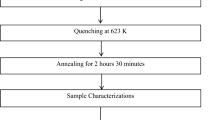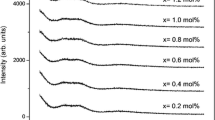Abstract
The ionic and polaronic conduction in mixed ionic electronic 98[20Li2O-xBi2O3-(80 − x)TeO2]-2Ag (x = 3, 5, 7, 11, 13, and 15 mol%) glasses had been analyzed with several theoretical models. The anomalous drop in logσDC for the investigated glass samples from x = 7 mol% to x = 11 mol% can be attributed to mixed ionic electronic effect (MIE) effect. The minimum in the MIE region is suggested to be due to a blocking effect on Li+ ion migration throughout the glass matrix. According to Almond-West formalism, the blocking Bi3+ ions to Li+ ions may induce high activation energy required for the formation of mobile carriers EC at x = 7 mol%, reducing the mobile Li+ ions available for ionic DC conductivity. Meanwhile, in ionic diffusion model, the blocking of Li+ ions may reduce the defect site concentration n at x = 11 mol% causing Li+ ions to migrate more slowly through the percolation channels. Anderson-Stuart activation energy EA analysis revealed that the accumulation of large BiO6 units in interstitial sites due to blocking effect may provide smaller size of interstitial openings for Li+ ions hence requiring high strain energy ES for ionic migration through the glass network. In addition, in the small polaron hopping model, the high number of BO units at x = 7 and 11 mol% may result in a decrease in density of states near Fermi level N(EF). The decrease in N(EF) may induce high activation energy W required for polaron hopping. Nonetheless, polaron hopping energy WH had a lower influence on total activation energy W than disordered energy WD, indicating that structural changes (BO/NBO formation) play a significant role in the polaron hopping mechanism.














Similar content being viewed by others
Data availability
The data that has been used is confidential.
References
Souri D (2011) Effect of molybdenum trioxide molar ratio on the optical and some physical properties of tellurite–vanadate–molybdate glasses. Measurement 44(4):717–721
Sidkey MA, Gaafar MS (2004) Ultrasonic studies on the network structure of ternary TeO2–WO3–K2O glass system. Phys B: Condensed Matter 348(1–4):46–55
Sidkey MA, El-Mallawany R, Nakhla RI, Abd El-Moneim A (1997) Ultrasonic attenuation at low temperature of TeO2–V2O5 glasses. Phys Status Solidi (a) 159(2):397–404
Desirena H, Schülzgen A, Sabet S, Ramos-Ortiz G, De la Rosa E, Peyghambarian N (2009) Effect of alkali metal oxides R2O (R= Li, Na, K, Rb and Cs) and network intermediate MO (M= Zn, Mg, Ba and Pb) in tellurite glasses. Opt Mater 31(6):784–789
Lin J, Huang W, Sun Z, Ray CS, Day DE (2004) Structure and non-linear optical performance of TeO2–Nb2O5–ZnO glasses. J Non-Cryst Solids 336(3):189–194
El-Mallawany R, Abousehly A, Yousef E (2000) Elastic moduli of tricomponent tellurite glasses TeO2-V2O5-Ag2O. J Mater Sci Lett 19(5):409–411
Al-Buriahi MS, Sayyed MI, Al-Hadeethi Y (2020) Role of TeO2 in radiation shielding characteristics of calcium boro-tellurite glasses. Ceram, Int
Sen S, Ghosh A (1999) Multiphonon assisted hopping in strontium vanadate semiconducting glasses. J Phys Condens Matter 11(6):1529
Mandal S, Ghosh A (1996) Electrical conduction in lead-iron glasses. J Phys Condens Matter 8(7):829
Pach K, Golis E, Sitarz M, Filipecki J (2018) Structural studies of tellurite glasses doped with erbium ions. J Mol Struct 1164:328–333
Saritha D, Markandeya Y, Salagram M, Vithal M, Singh AK, Bhikshamaiah G (2008) Effect of Bi2O3 on physical, optical and structural studies of ZnO–Bi2O3–B2O3 glasses. J Non-Cryst Solids 354(52–54):5573–5579
Ram R, Bhattacharya S (2023) Mixed ionic-electronic transport in Na2O doped glassy electrolytes: promising candidate for new generation sodium ion battery electrolytes. J Appl Phys 133(14)
Moguš-Milanković A, Šantić A, Ličina V, Day DE (2005) Dielectric behaviour and impedance spectroscopy of bismuth iron phosphate glasses. J Non-Cryst Solids 351(40–42):3235–3245
Bih L, El Omari M, Réau JM, Haddad M, Boudlich D, Yacoubi A, Nadiri A (2000) Electronic and ionic conductivity of glasses inside the Li2O–MoO3–P2O5 system. Solid State Ion 132(1–2):71–85
Dutta D, Ghosh A (2005) Dynamics of Ag+ ions in binary tellurite glasses. Phys Rev B 72(2):024201
Ferreira Nascimento ML (2013) Determination of mobility and charge carriers concentration from ionic conductivity in sodium germanate glasses above and below. Int Sch Res Not 2013
Sayer M, Mansingh A (1972) Transport properties of semiconducting phosphate glasses. Phys Rev B 6(12):4629
Ibrahim AM, Elbashar YH, Badr AM, Elshaikh HA, Mostafa AG (2017) Mixed ionic–polaronic conduction in copper sodium phosphate glasses containing aluminium oxide. J Microw Power Electromagn Energy 51(1):71–89
Jayasinghe GDLK, Dissanayake MAKL, Bandaranayake PWSK, Souquet JL, Foscallo D (1999) Electronic to ionic conductivity of glasses in the Li2O–V2O5–TeO2 system. Solid State Ion 121(1–4):19–23
Anderson OL, Stuart DA (1954) Calculation of activation energy of ionic conductivity in silica glasses by classical methods. J Am Ceram Soc 37(12):573–580
Moawad HM, Jain H, El-Mallawany R (2009) DC conductivity of silver vanadium tellurite glasses. J Phys Chem Solids 70(1):224–233
Holstein T (1959) Studies of polaron motion: part I. The molecular-crystal model. Ann Phys 8(3):325-342
Lebrun N, Levy M, Souquet JL (1990) Electronic conductivity in glasses of the TeO2-V2O5-MoO3 system. Solid State Ionics 40:718–722
Tanaka K, Yoko T, Nakano M, Nakamura M, Kamiya K (1990) Electronic conduction in Fe2O3-TeO2-P2O5 glasses: an explication for high conductivity of iron-containing tellurite glasses. J Non-Cryst Solids 125(3):264–271
Chamuah A, Ojha S, Bhattacharya K, Ghosh CK, Bhattacharya S (2022) AC conductivity and electrical relaxation of a promising Ag2S-Ge-Te-Se chalcogenide glassy system. J Phys Chem Solids 166:110695
Hisam R, Yahya AK, Mohamed Kamari H, Talib ZA (2017) AC conductivity and dielectric behavior in mixed electronic-ionic 30Li2O–4MoO3–(66–x) TeO2–xV2O5 glass system. Ionics 23(6):1423–1437
Rao PSG, Siripuram R, Sripada S (2019) Impedance analysis of TeO2-SeO2-Li2O nano glass system. Results Phys 13:102133
Rani S, Sanghi S, Ahlawat N, Agarwal A (2014) Influence of Bi2O3 on thermal, structural and dielectric properties of lithium zinc bismuth borate glasses. J Alloy Compd 597:110–118
Sutrisno MS, Samsudin NM, Sazali ES, Hisam R (2021) AC conductivity and dielectric properties of 98[20Li2O-xBi2O3-(80–x)TeO2]-2Ag mixed ionic-electronic glasses. J Mater Sci Mater Electron 32(4):5138–5155
Almond DP, Hunter CC, West AR (1984) The extraction of ionic conductivities and hopping rates from ac conductivity data. J Mater Sci 19(10):3236–3248
Almond DP, Duncan GK, West AR (1983) The determination of hopping rates and carrier concentrations in ionic conductors by a new analysis of ac conductivity. Solid State Ionics 8(2):159–164
Almond DP, West AR (1983) Mobile ion concentrations in solid electrolytes from an analysis of ac conductivity. Solid State Ionics 9:277–282
Chatterjee A, Ghosh A (2018) Correlation between ion transport and network structure of Li2O-P2O5 glasses. Solid State Ionics 314:1–8
Sutrisno MS, Sabri NS, Hisam R (2021) Effects of Bi2O3 on DC conductivity and nonlinear optical properties of mixed ionic–electronic 98[20Li2O-xBi2O3-(80–x)TeO2]-2Ag glass system. Appl Phys A 127(10):1–14
Elliott RJ, Perondi L, Barrio RA (1994) Ionic conduction in (1–x)B2O3+ xLi2O. J Non-Cryst Solids 168(1–2):167–178
Ojovan MI (2021) The modified random network (MRN) model within the configuron percolation theory (CPT) of glass transition. Ceramics 4(2):121–134
Swenson J, Matic A, Karlsson C, Börjesson L, Meneghini C, Howells WS (2001) Random ion distribution model: a structural approach to the mixed-alkali effect in glasses. Phys Rev B 63(13):132202
Kahnt H (1996) Ionic transport in glasses. J Non-Cryst Solids 203:225–231
Nascimento MLF (2007) Test of the Anderson-Stuart model and correlation between free volume and the ‘universal’ conductivity in sodium silicate glasses. J Mater Sci 42(11):3841–3850
Coon J, Shelby JE (1990) Properties and structure of lead halosilicate glasses. J Am Ceram Soc 73(2):379–382
Mott NF (1968) Conduction in glasses containing transition metal ions. J Non-Cryst Solids 1(1):1–17
Mott NF, Davis EA (2012) Electronic processes in non-crystalline materials. Oxford University Press
Schirmer OF, Wittwer V, Baur G, Brandt G (1977) Dependence of WO 3 electrochromic absorption on crystallinity. J Electrochem Soc 124(5):749
Guo C, Yin S, Dong Q, Sato T (2012) Near-infrared absorption properties of RbxWO3 nanoparticles. CrystEngComm 14(22):7727–7732
Zhou Y, Li N, Xin Y, Cao X, Ji S, Jin P (2017) CsxWO3 nanoparticle-based organic polymer transparent foils: low haze, high near infrared-shielding ability and excellent photochromic stability. J Mater Chem C 5(25):6251–6258
Austin IG, Mott NF (1969) Polarons in crystalline and non-crystalline materials. Adv Phys 18(71):41–102
Anderson PW (1958) Absence of diffusion in certain random lattices. Phys Rev 109(5):1492
Schirmer OF (1976) Optical absorption of small polarons bound in octahedral symmetry: V-type centers in alkaline earth oxides. Zeitschrift für Physik B Condensed Matter 24(3):235–244
Punia R, Kundu RS, Murugavel S, Kishore N (2012) Hopping conduction in bismuth modified zinc vanadate glasses: an applicability of Mott’s model. J Appl Phys 112(11):113716
Shaltout I, Tang YI, Braunstein R, Shaisha EE (1996) FTIR spectra and some optical properties of tungstate-tellurite glasses. J Phys Chem Solids 57(9):1223–1230
Elkholy MM, El-Mallawany RA (1995) Ac conductivity of tellurite glasses. Mater Chem Phys 40(3):163–167
Emin D, Seager CH, Quinn RK (1972) Small-polaron hopping motion in some chalcogenide glasses. Phys Rev Lett 28(13):813
Kumar MP, Sankarappa T (2009) DC conductivity of rare earth ions doped vanado-tellurite glasses. J Non-Cryst Solids 355(4–5):295–300
Nagaraja N, Sankarappa T, Kumar MP (2008) Electrical conductivity studies in single and mixed alkali doped cobalt–borate glasses. J Non-Cryst Solids 354(14):1503–1508
Acknowledgements
The authors express gratitude to the Research Management Centre (RMC), Universiti Teknologi MARA, for assistance throughout the research. This study was funded by Ministry of Higher Education through Fundamental Research Grant Scheme (FRGS) with code FRGS/1/2018/STG02/UITM/02/9.
Funding
This research was financially supported by the Ministry of Higher Education Malaysia under the Fundamental Research Grant Scheme (FRGS), FRGS/1/2018/STG02/UITM/02/9. The funding source had no role in the study design, data collection, analysis, interpretation, writing of the manuscript, or the decision to submit it for publication.
Author information
Authors and Affiliations
Contributions
All authors have significantly contributed to this research and manuscript. MSS: conceptualization, data curation, formal analysis, investigation, methodology, project administration, resources, validation, visualization, writing—original draft, writing—review and editing. RH: funding acquisition, investigation, supervision, validation, writing—review and editing. All authors have reviewed and approved the final version of this manuscript.
Corresponding author
Ethics declarations
Ethical approval
The research presented in this manuscript has been conducted in strict adherence to ethical guidelines and principles.
Competing interests
The authors declare no competing interests.
Additional information
Publisher's Note
Springer Nature remains neutral with regard to jurisdictional claims in published maps and institutional affiliations.
Rights and permissions
Springer Nature or its licensor (e.g. a society or other partner) holds exclusive rights to this article under a publishing agreement with the author(s) or other rightsholder(s); author self-archiving of the accepted manuscript version of this article is solely governed by the terms of such publishing agreement and applicable law.
About this article
Cite this article
Sutrisno, M.S., Hisam, R. Ionic and polaronic conduction in mixed ionic-electronic 98[20Li2O-xBi2O3-(80 − x)TeO2]-2Ag glass system. Ionics 30, 271–283 (2024). https://doi.org/10.1007/s11581-023-05301-7
Received:
Revised:
Accepted:
Published:
Issue Date:
DOI: https://doi.org/10.1007/s11581-023-05301-7




